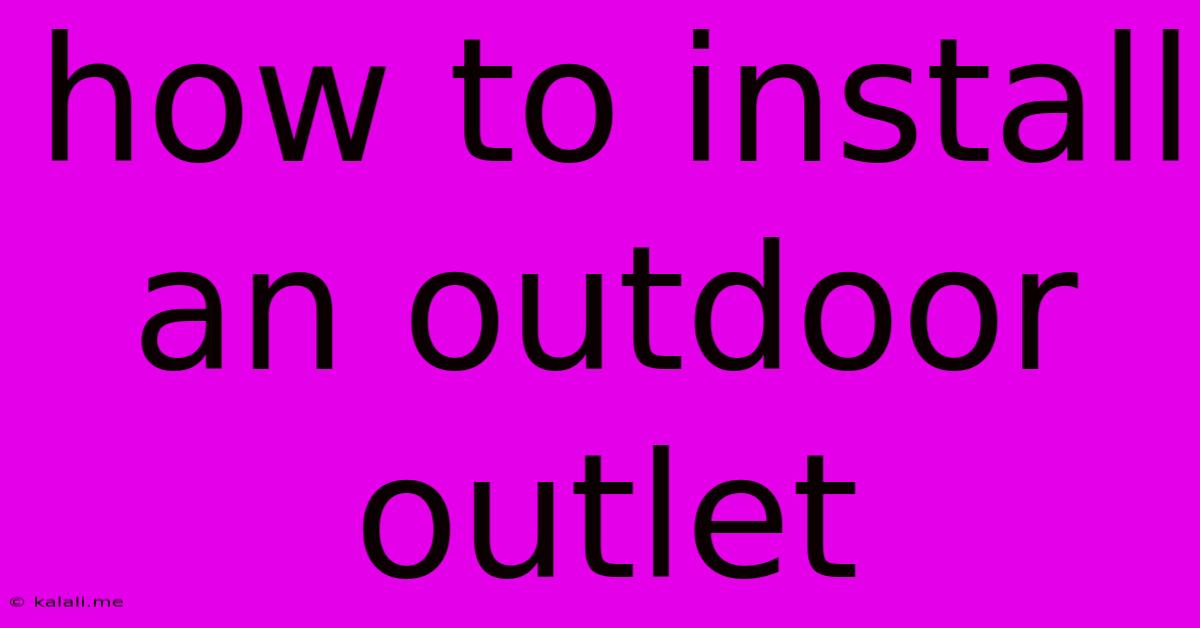How To Install An Outdoor Outlet
Kalali
Jun 06, 2025 · 4 min read

Table of Contents
How to Safely Install an Outdoor Outlet
Adding an outdoor outlet significantly enhances the functionality and convenience of your home, allowing you to power various outdoor appliances and decorations. However, improper installation can pose serious safety risks. This comprehensive guide will walk you through the process of safely installing an outdoor outlet, ensuring both functionality and safety. This includes choosing the right outlet, gathering necessary tools, and understanding the crucial electrical safety precautions.
Why You Need an Outdoor Outlet:
Outdoor outlets are essential for powering a variety of devices, enhancing both practicality and enjoyment of your outdoor spaces. From string lights and holiday decorations to power tools for yard work and even charging electric lawnmowers, a conveniently located outdoor outlet offers unparalleled flexibility.
Choosing the Right Outdoor Outlet:
The selection of your outdoor outlet is crucial for its longevity and safety. Look for an outlet rated for outdoor use, indicated by a weatherproof or waterproof designation. These typically feature a sealed cover to protect the internal components from moisture and debris. Consider the amperage rating based on the planned load. A higher amperage rating offers greater flexibility for future needs. Finally, ground fault circuit interrupter (GFCI) protection is highly recommended for outdoor outlets to minimize the risk of electric shock. GFCI outlets are designed to immediately cut off the power if a ground fault is detected.
Tools and Materials You'll Need:
Before beginning, ensure you have all the necessary tools and materials. This will make the installation process smoother and more efficient. You'll likely need:
- Outdoor-rated GFCI outlet: Choose one that matches your existing electrical system.
- Weatherproof electrical box: This provides protection from the elements.
- Electrical conduit (optional but recommended): Protects the wiring from damage.
- Non-metallic sheathed cable (NM-B): Also known as Romex, this is the standard wiring for most homes. Ensure it's rated for outdoor use.
- Wire connectors (wire nuts): For securely joining wires.
- Voltage tester: To ensure power is off before working with the wiring.
- Wire strippers/cutters: To prepare the ends of the wires for connection.
- Screwdrivers (Phillips and flathead): For securing the outlet and electrical box.
- Drill and appropriate drill bits: For drilling holes in the wall or siding if necessary.
- Level: To ensure the electrical box is properly installed.
- Safety glasses and gloves: To protect yourself from injury.
Step-by-Step Installation Guide:
1. Turn Off the Power: This is the most critical step. Locate the circuit breaker controlling the area where you'll be installing the outlet and turn it OFF. Use a voltage tester to double-check that the power is indeed off.
2. Mount the Electrical Box: Choose a suitable location that's accessible yet protected from the elements. If drilling is required, carefully drill the holes and secure the box to the wall or siding using appropriate fasteners. Ensure the box is level.
3. Run the Wiring: Carefully route the NM-B cable from your existing electrical circuit to the new outdoor box. Use conduit if possible to protect the wiring. Secure the cable within the box using cable clamps.
4. Connect the Wires: Carefully strip the insulation from the ends of the wires, following the color code (black = hot, white = neutral, bare copper = ground). Connect the wires to the corresponding terminals on the GFCI outlet using wire connectors. Always ensure a tight connection to avoid overheating.
5. Install the Outlet: Secure the outlet in the electrical box, ensuring the cover is properly attached.
6. Test the Outlet: Turn the circuit breaker back ON. Use a voltage tester to confirm the power is flowing correctly. Test the GFCI function by pressing the "Test" button; the outlet should cut off power. Then press the "Reset" button to restore power.
Important Safety Precautions:
- Never work with electricity if you are not comfortable or familiar with the process. Consider hiring a qualified electrician if you have any doubts.
- Always turn off the power at the circuit breaker before starting any work.
- Use appropriate safety gear, including safety glasses and gloves.
- Inspect all connections thoroughly before turning the power back on.
- Ensure the outlet is properly grounded to prevent electric shock.
- Regularly inspect the outlet and wiring for any signs of damage.
By following these steps and prioritizing safety, you can successfully install an outdoor outlet and enjoy the added convenience and functionality it provides. Remember, safety should always be your top priority when working with electricity. If you're unsure about any aspect of this process, it is always best to consult a qualified electrician.
Latest Posts
Latest Posts
-
How To Ask A Colleague Out
Jun 07, 2025
-
How Long Do Fridge Water Filters Last
Jun 07, 2025
-
Size Of A Handy Haversack Vs Bag Of Holding
Jun 07, 2025
-
Can You Pour A Concrete Slab In Sections
Jun 07, 2025
-
Can A Bad Starter Drain Your Battery
Jun 07, 2025
Related Post
Thank you for visiting our website which covers about How To Install An Outdoor Outlet . We hope the information provided has been useful to you. Feel free to contact us if you have any questions or need further assistance. See you next time and don't miss to bookmark.